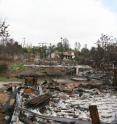NIST study offers first detailed look at the progress of a wildland-urban fire
A wildfire rages across southern California wildlands towards residential communities, endangering residents and firefighters and sending property up in smoke. This is an increasingly common story, occurring several times a summer. To better understand these Wildland-Urban Interface (WUI) fires and how best to prevent or fight them, researchers at the National Institute of Standards and Technology (NIST) have issued an in-depth study on fire behavior and defensive actions taken in a community during a such a fire. WUI fires are becoming more prevalent as housing developments push into former wilderness areas. Drought is believed to also be a major contributor to larger wildfires. In addition to southern California, WUI fires also burn across the southern United States and in countries such as Australia, Greece, Italy and Spain. Little research has been conducted on understanding WUI fire behavior and on the effectiveness of current risk mitigation strategies.
The new NIST study examines in detail the events in one representative community during the Oct. 21-22, 2007 “Witch Fire” north of San Diego, Calif. The Witch Fire was the largest of the 2007 California fire storm. The fire burned 197,990 acres (80,124 hectares) and destroyed more than 1,100 homes. Fire damage was estimated at $1.8 billion and suppression costs were $18 million.
For their study, fire researchers Alex Maranghides and Ruddy Mell tracked down every fire captain who worked in the fire at The Trails housing development in Rancho Bernardo to follow the fire’s evolution. The NIST researchers, with the support of The Trails Homeowners Association, also collected event timeline information from homeowners. Of the 274 homes in The Trails neighborhood, 245 were within the fire’s perimeter. Of those, 74 homes were completely destroyed and 16 were partly damaged.
The data collection tracked the fire’s approach from the wildlands, the effects of the fire in the community and defensive actions taken by owners and first responders. Researchers documented the construction characteristics of the destroyed homes and the wildland and residential vegetation damage immediately after the fire.
The study revealed that two-thirds of all the homes destroyed were ignited either directly or indirectly by embers. “This is an important finding because current guidelines to make structures more fire resistant offer little guidance on how to make structures more resistant to an ember attack,” fire researcher Alex Maranghides explains. Researchers also learned that one-third of all structures within the fire perimeter were defended by first responders and/or homeowners.
The NIST report is the first in a series of three publications to understand WUI fire behavior. The second publication, in progress, will examine the role of construction and landscaping on the probability of a structure’s survival. A third report will describe a study that uses the data to build a computer-generated virtual community to test the fire behavior predicted by different fire models and compare the results to the observed fire behavior and structural response.
Source: National Institute of Standards and Technology (NIST)
Other sources
- NIST study offers first detailed look at the progress of a wildland-urban firefrom PhysorgWed, 17 Jun 2009, 14:56:06 UTC
